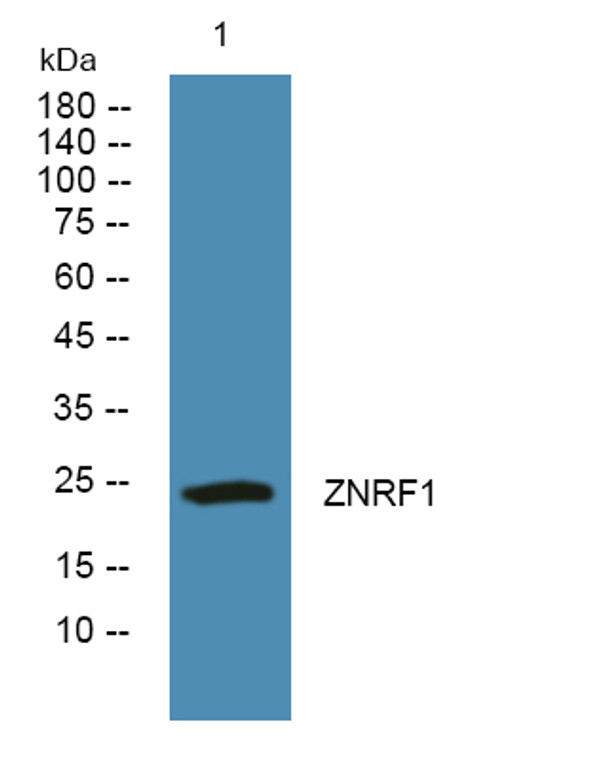| Host: |
Rabbit |
| Applications: |
WB/ELISA |
| Reactivity: |
Human/Mouse |
| Note: |
STRICTLY FOR FURTHER SCIENTIFIC RESEARCH USE ONLY (RUO). MUST NOT TO BE USED IN DIAGNOSTIC OR THERAPEUTIC APPLICATIONS. |
| Short Description: |
Rabbit polyclonal antibody anti-E3 ubiquitin-protein ligase ZNRF1 is suitable for use in Western Blot and ELISA research applications. |
| Clonality: |
Polyclonal |
| Conjugation: |
Unconjugated |
| Isotype: |
IgG |
| Formulation: |
Liquid in PBS containing 50% Glycerol and 0.02% Sodium Azide. |
| Purification: |
The antibody was affinity-purified from rabbit antiserum by affinity-chromatography using epitope-specific immunogen. |
| Concentration: |
1 mg/mL |
| Dilution Range: |
WB 1:500-2000ELISA 1:5000-20000 |
| Storage Instruction: |
Store at-20°C for up to 1 year from the date of receipt, and avoid repeat freeze-thaw cycles. |
| Gene Symbol: |
ZNRF1 |
| Gene ID: |
84937 |
| Uniprot ID: |
ZNRF1_HUMAN |
| Specificity: |
ZNRF1 Polyclonal Antibody detects endogenous levels of protein. |
| Immunogen: |
Synthesized peptide derived from part of the human protein |
| Post Translational Modifications | N-myristoylation targets ZNRF1 to intracellular membranes. Phosophorylated by SRC at Tyr-103.leading to 'Lys-63'-linked ubiquitination of TLR3, lysosomal trafficking and degradation. |
| Function | E3 ubiquitin-protein ligase that plays a role in different processes including cell differentiation, receptor recycling or regulation of inflammation. Mediates the ubiquitination of AKT1 and GLUL, thereby playing a role in neuron cells differentiation. Plays a role in the establishment and maintenance of neuronal transmission and plasticity. Regulates Schwann cells differentiation by mediating ubiquitination of GLUL. Promotes neurodegeneration by mediating 'Lys-48'-linked polyubiquitination and subsequent degradation of AKT1 in axons: degradation of AKT1 prevents AKT1-mediated phosphorylation of GSK3B, leading to GSK3B activation and phosphorylation of DPYSL2/CRMP2 followed by destabilization of microtubule assembly in axons. Ubiquitinates the Na(+)/K(+) ATPase alpha-1 subunit/ATP1A1 and thereby influences its endocytosis and/or degradation. Controls ligand-induced EGFR signaling via mediating receptor ubiquitination and recruitment of the ESCRT machinery. Acts as a negative feedback mechanism controlling TLR3 trafficking by mediating TLR3 'Lys-63'-linked polyubiquitination to reduce type I IFN production. Modulates inflammation by promoting caveolin-1/CAV1 ubiquitination and degradation to regulate TLR4-activated immune response. |
| Protein Name | E3 Ubiquitin-Protein Ligase Znrf1Nerve Injury-Induced Gene 283 ProteinRing-Type E3 Ubiquitin Transferase Znrf1Zinc/Ring Finger Protein 1 |
| Database Links | Reactome: R-HSA-983168 |
| Cellular Localisation | EndosomeLysosomeMembranePeripheral Membrane ProteinCytoplasmic VesicleSecretory VesicleSynaptic Vesicle MembraneAssociated With Synaptic Vesicle Membranes In Neurons |
| Alternative Antibody Names | Anti-E3 Ubiquitin-Protein Ligase Znrf1 antibodyAnti-Nerve Injury-Induced Gene 283 Protein antibodyAnti-Ring-Type E3 Ubiquitin Transferase Znrf1 antibodyAnti-Zinc/Ring Finger Protein 1 antibodyAnti-ZNRF1 antibodyAnti-NIN283 antibody |
Information sourced from Uniprot.org
12 months for antibodies. 6 months for ELISA Kits. Please see website T&Cs for further guidance







